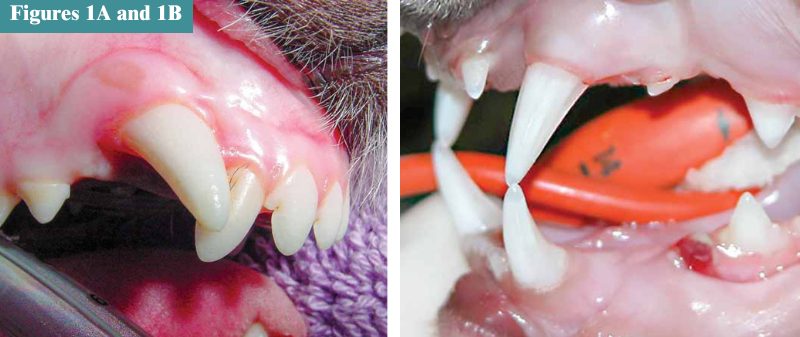Last month’s column discussed passive orthodontic devices called composite extensions for moving mandibular canine teeth and the ethics of orthodontic movement in pets. This month covers cases in which active orthodontic devices are used to correct mesioversion of maxillary canine teeth.
What is it?
Mesioversion is a forward tipping of the crown of a tooth. This condition may result in abnormal tooth-to-tooth contact or tooth-to-soft tissue contact. While this can occur with any tooth, it is common with the maxillary canine teeth (Figures 1A and 1B). Mesioversion of the maxillary canine teeth occurs most commonly in certain breeds: Shetland sheepdogs and Siamese cats. A layman’s term for mesioversion of the maxillary canine teeth is “lance canines” or “spear canines” due to the potentially horizontal position of the large crown of the canine tooth.

The normal relationship between the maxillary and mandibular canine teeth is the mandibular canine tooth sits in a diastema between the maxillary third incisor and the maxillary canine tooth. If the maxillary canine tooth is displaced mesially, this prevents the mandibular canine tooth from fitting into that diastema and may affect the ability of the dog or cat to close its mouth.
Mesioversion cases
Simon was a one-year-old male neutered Siamese cat that presented to the Dentistry and Oral Surgery Service at the Veterinary Hospital of the University of Pennsylvania in 2004. Ever since he was approximately six months old, he was unable to close his mouth. Alexander Reiter, Dipl. Tzt., Dr. med. Vet., DAVDC, DEVDC, Jennifer Rawlinson, DVM, DAVDC, DAVDC (Equine), and I saw Simon for a consultation after being treated at a specialty practice for inability to close the mouth. The initial diagnosis at another specialty practice was a possible temporomandibular joint (TMJ) abnormality, and to stabilize the TMJs, the specialty hospital wired the jaw in place for several weeks. After the removal of the wires, the problem of the inability to close the mouth persisted.
On physical examination, it became apparent Simon’s mouth could open to full extension without crepitus or abnormal laxity. Still, the most significant finding was the tooth-to-tooth contact between the maxillary and mandibular canine teeth that were meeting at their cusps due to moderate mesioversion of teeth 104 and 204 (Figure 1B).
Other differential diagnoses, such as open-mouth jaw locking and mandibular neurapraxia (trigeminal neuropathy) were considered unlikely due to the tooth-to-tooth contact and normal motor control of the mandible.
Treatment plan
We discussed our examination findings with Simon’s owner. If we were able to actively move Simon’s maxillary canine teeth to a distal position, this may allow the mandibular canine teeth to fit into their normal diastema, allowing for full mouth closure. Simon’s owner agreed with the plan to place active orthodontic devices (braces) bilaterally to move the maxillary canine teeth distally.
Since the maxillary canine teeth have a huge amount of root surface area, orthodontic movement of the teeth can be complicated. An elastic orthodontic chain is utilized to attach the tooth of interest to anchor teeth. The surface area of the roots of the anchor teeth needs to be greater than the surface area of the tooth that requires movement, or else the anchor teeth will move instead of the target tooth.
The chain is attached to the target tooth and the anchor teeth with buttons, brackets or wire incorporated into dental composite. A dental composite bonded to multiple anchor teeth joins two smaller teeth together to provide the surface area needed to move the target tooth.
The elastic chain is measured at rest, and then its force is activated by spanning that length with 80 percent of its at-rest length. This provides constant, gentle tension on the tooth of interest (Figure 2). Placing too much tension on the tooth is a bad thing and will delay movement of the tooth, resulting in undermining resorption of bone and possibly even tooth resorption. If forces are applied appropriately, within a matter of weeks, the tooth will move to the desired location.

Simon’s tooth movement went very well, and within weeks, he was able to close his mouth (Figure 3). The elastic chains were kept in place under no tension for weeks to act as a retainer, but due to the newly created dental interlock, chances of mesial drift were considered to be unlikely. The composite material, wire, buttons and elastic chains were removed under anesthesia, and Simon went on to enjoy his newfound ability to fully close his mouth.

John R. Lewis, VMD, DAVDC, Fellow, AVDC OMFS, practices at Veterinary Dentistry Specialists and teaches at Silo Academy Education Center, both located in Chadds Ford, Pa.
